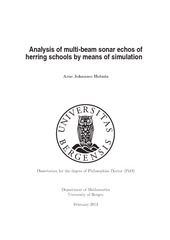| dc.description.abstract | The synchronized behavior of large schools of fish can be a fascinating sight and has caught the attention of researchers for decades. Schools of thousands, or even millions of fish can seemingly function as a single entity, by mechanisms that are still not entirely understood. Models describing the individual behavior (individual based models) have been shown to predict certain schooling features such as predator avoidance, whereas experiments with fish schools in tanks have revealed rules governing the interaction between neighboring fish. However, the step from an individual based model or a school of a limited number of fish in a tank experiment, to large free swimming schools in the ocean, may include challenges with regards to the observation techniques and to conditions of the environment that are not necessarily reproduced in the individual based model or in the tank. The latest technological advances in underwater acoustic observation has introduced the potential of observing schools of fish of size up to a few hundred meters by threedimensional images generated by multi-beam sonars. The Simrad MS70 multi-beam sonar provides true three-dimensional images at a temporal resolution down to approximately one image per second, enabling observations of the dynamic behavior of large fish schools in situ, at a spatial and temporal resolution that has not been previously available. In this thesis, data from the MS70 sonar are analyzed by means of simulation, and steps are taken towards establishing a link between the modeled behavior of an individual and the observed behavior of real fish schools. The principal analytical tool utilized in the thesis is a simulation model developed by the author (and co-authors), which simulates observations from multi-beam sonars based on the positions, orientations, and acoustical properties of arbitrary groups of individual fish, and the configuration and acoustical properties of the sonar and the environment. The framework of the simulation model is presented in the first of three papers in the thesis, along with examples of its use as implemented for the EK60 multi-frequency echosounder, the ME70 multi-beam echosounder, and the MS70 multi-beam sonar, all manufactured by Simrad. The simulation experiments shown in the first paper illustrate for example the potential of the MS70 sonar to provide information about the behavior of fish schools. Specifically, in one of the experiments, a herring school with original mean heading perpendicular to the central sonar beams is modified to represent eight different idealized orientation scenarios, obtained by rotating the fish in specific sections of the school by 90° towards the sonar. This produced reduced backscatter in the sections of the school which were rotated, due to the directionality of the scattering from herring at the acoustic frequencies of the sonar, showing the potential for falsely interpreting orientation changes as fish density changes, but also the potential for extracting information about the local orientation distribution of the school. In the second paper, the parameters and stochastic properties of the noise (defined as all contributions to the received acoustic intensity not backscattered from targets) present in data from the MS70 sonar and EK60 echosounder are estimated from passive recording sequences, motivated by the following three potential uses: (1) subtraction of noise from real data, (2) simulation of noise in synthetic data, and (3) to provide a basis for the development of methods for segmentation of MS70 data of fish schools (applied in the third paper). Particularly, a simulation experiment from the first paper is repeated with addition of noise, in which the polarization (degree of alignment of the individual fish) of a real school which had been circumnavigated by the vessel for several rounds, was estimated by matching the total backscatter of the real school and the total backscatter of simulated schools with a variety of polarizations and packing densities. The experiment illustrates the effect of noise on the estimated polarization, and the potential to infer packing density of the school from the simulation experiment. The estimated noise from the second paper is utilized in the third and final paper, in the development and testing of a new segmentation method for multi-beam sonar data, which is compared to an existing segmentation method implemented in the post processing system LSSS (Large Scale Survey System). The new method applies a Bayesian approach, where the cumulative distribution function (CDF) of the packing density of omnidirectional targets (scattering equally in all directions) in a voxel is estimated based on the observed data, the estimated noise, and a prior probability distribution of the signal. The CDF is evaluated at a specified lower schooling threshold, and the resulting probabilities that the packing density is below the schooling threshold is smoothed by a Gaussian kernel in the logarithmic domain (implying products of the probabilities in the neighborhood around the voxel). Voxels for which the smoothed probability is below a segmentation threshold, are identified to contain the school. The two segmentation methods are tested on simulated data of 240 herring schools of various shapes, sizes, packing densities, and depths, and compared with ground truth segmentation data generated from the fish positions used as input to the simulation model to identify recommended parameter settings for both methods, and to determine differences in the performance between the methods. The new method is shown to produce estimates of the school extent, total volume, total target strength (total echo), and mean volume backscattering strength (mean echo density) which are generally closer to the corresponding theoretical values estimated from the ground truth segmentation data. | en_US |
| dc.relation.haspart | Paper 1: Arne Johannes Holmin, Nils Olav Handegard, Rolf J. Korneliussen, Dag Tjøstheim, Simulations of multi-beam sonar echos from schooling individual fish in a quiet environment, The Journal of the Acoustical Society of America 132, 6 (2012), 3720- 3734. The article is available at: <a href="http://hdl.handle.net/1956/6958" target="blank">http://hdl.handle.net/1956/6958</a> | en_US |
